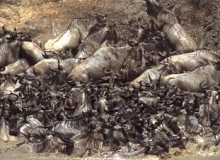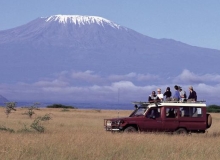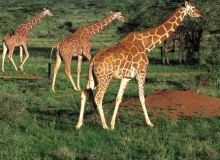
0208 777 4873
Places to see: Africa

NGORONGORO CONSERVATION AREA
Since most of the Crater floor is grassland, grazing animals predominate: gnu, zebra, gazelles, buffalo, eland, kongoni and warthogs. The swamp and forests provide additional resources for hippos, rhinos, elephants, waterbucks, reedbucks and bushbucks, baboons and vervets .The steep inner slopes provide a habitat for decides and the rare mountain reedbuck. With so many prey animals' predators such as lions, hyenas and jackals are also present. Birds commonly found in this area re Stonechat, Augur Buzzards, Schalow's Wheatear, Fiscals Shrike, white Verreaux's Eagle and more. The conservation area also covers Olduvai Gorge and Laetoli, which give us fascinating glimpses of our own evolution through the past four million years. This may be one of the places where we all began.

MASAI MARA GAME RESERVE
The park is probably the most famous and most visited reserve in Kenya. The terrain consists of vast stretches of uninterrupted plains on the eastern side and as you go further the savannah spotted with acacia woodlands gives way to a more varied landscape with hills and mountains. The park is teeming with wildlife and the mostly permanent water network from the Mara-Talek rivers provides the animals with a year round supply of water. The most spectacular feature is the annual migration of wildebeest, zebra and gazelle from the plains of Serengeti that cross the Tanzanian border and rivers to reach the Mara's grasslands from late June, tracked by predators: lion, leopard, cheetah, hyena and circled by vultures as the journey unfolds, the migration provides a game viewing experience that is not equaled anywhere else in Africa. Game includes :- elephant, Black Rhino, buffalo, wildebeest, Burchell's zebra, hartebeest, various antelope and gazelle, lion, leopard, giraffe, elephant cheetah, hippo, crocodile and much more.
Area: 1,510 square kilometers
By Road : 4-5 hours from Nairobi
By Air: Twice daily Nairobi/Mara/Nairobi, once daily Nanyuki/Masai Mara, once daily Mombasa/Nairobi, once daily Samburu/Masai Mara

AMBOSELI NATIONAL PARK
Amboseli means "A place of water", is situated at the foothills of Mount Kilimanjaro. Despite its sometimes dry and dusty appearance, the park has an endless water supply filtered through thousands of feet of volcanic rock from Kilimanjaro's snow melt. The landscape is open and bushy savannah dotted with thickets and some acacias. It is an important rangeland in Maasai culture.The park offers a wide variety of wildlife but the principal attraction is its vast herds of elephant within the park. The bull elephants here have some of the largest tusks in Kenya. Other game includes: zebra, wildebeest, giraffe, impala, leopard, caracal and serval cat. The park boasts a rich bird life such as ibis, egret, avocet, common and saddle-billed stork, secretary bird, heron, vultures, ducks, and geese.
Area: 392 square kilometers
By Road : 4-5 hours from Nairobi
By Air: Once daily Nairobi/Amboseli/Nairobi

SERENGETI NATIONAL PARK
It is 335 kms from Arusha, stretching north to Kenya and bordering Lake Victoria to the west. Vegetation is grassy plains, savannah with acacias, wooded hills and mountains are the backdrops for an extraordinary concentration of animals which reaches its peak during the wildebeest migration which generally takes place between December to May in the south of the park and from June to October to the west and the north. A million wildebeest, each driven by the same ancient rhythm, fulfilling their instinctive role in the inescapable cycle of life: a frenzied 3 week bout of territorial conquests and mating: survival of the fittest as 40 kilometers long columns plunge through crocodile infested waters on the annual exodus north. This is also a very good time to see the cats.


